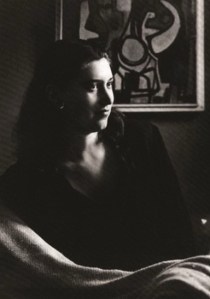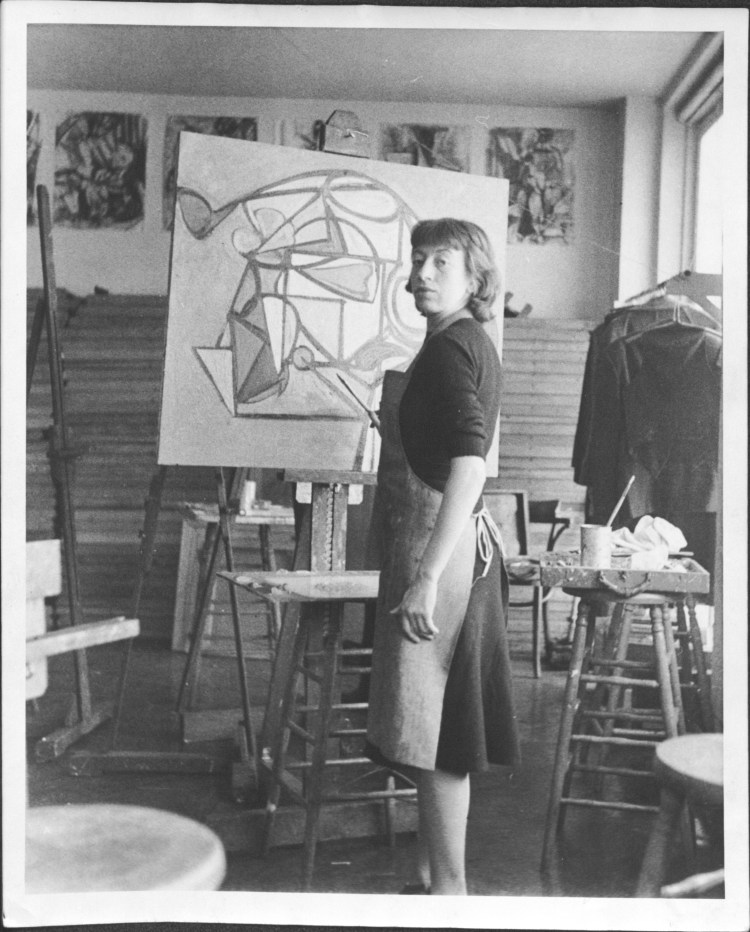
Lee Krasner in Hans Hoffman’s studio, early 1940s. Photo by Robert E. Mates and Paul Katz/Image courtesy of the Archives of American Art, Smithsonian Institution
There’s no concrete evidence that 20th-century artists Lee Krasner, Judith Rothschild and Lynne Drexler knew each other. But they shared influences, friends and even a teacher. They also all knew the experience of being overshadowed by either husbands or male peers in their day.
And right now, they are all getting their due in Maine.
The Farnsworth Art Museum is showing works by Drexler from the 1960s. The Ogunquit Museum of American Art is hosting the first ever show for Krasner in Maine with a focus on her early career. And Moss Galleries has mounted a sweeping retrospective for Rothschild.
The overlapping exhibitions reflect the overdue but growing desire by museums and collectors to tell a fuller story about the history of abstract expressionism in the United States. Elizabeth Moss, who owns fine art galleries in Portland and Falmouth, represents Drexler’s work through her estate and has stoked interest in her for years. She said Rothschild’s estate approached her in hopes of a similar resurgence.
“It is really important to me that these women have to have a voice, and in order for them to have a voice, they need to be in our institutions,” Moss said. “We’re not seeing the entire picture of our own culture without them in those stories and institutions. I’m happy that it’s beginning to happen, and I hope that we can support this momentum and really try to get some balanced perspective in our private and public collections of artists.”
All three studied with the legendary painter Hans Hoffman, who once famously said of Krasner that her work was “so good you would not know it was painted by a woman.”
“These women inevitably have to face the challenges of being an artist during this period where geometric abstraction was framed in the context of the hyper rational, which is always pinned on a certain gendered notion of masculinity,” said Devon Zimmerman, curator of modern and contemporary art at the Ogunquit Museum of American Art.
LEE KRASNER (1908-1984)
Krasner had a long career, but Zimmerman deliberately chose to focus the Ogunquit exhibition on the years before she met and married Jackson Pollock – the famous painter who has at times eclipsed her own star.
“The idea is, if we just look at Krasner’s life here and what she was doing on its own terms, what do we learn about her practice?” Zimmerman said. “What do we learn about her character, and what kind of threads can you unfurl and follow for the rest of her career? It’s kind of an early examination to understand by proxy the rest of her life and her approach to art.”
Krasner was the first child born in America to Russian-Jewish refugees. Zimmerman said she sought out art even as a teenager in New York, where she would have seen modernist exhibitions by influential European artists such as Piet Mondrian and Pablo Picasso. The Museum of Modern Art opened in 1929 and hosted a major show of cubist and abstract art in 1936. In 1937, Krasner studied with Hoffman and joined the newly formed American Abstract Artists, which provided early exhibition opportunities for abstract artists when few existed. She was socially and politically active, participating in debates and protests. She did not have any known connection to Maine but associated with many artists who did. Zimmerman said the network she formed early in her career would eventually help launch Pollock’s own.
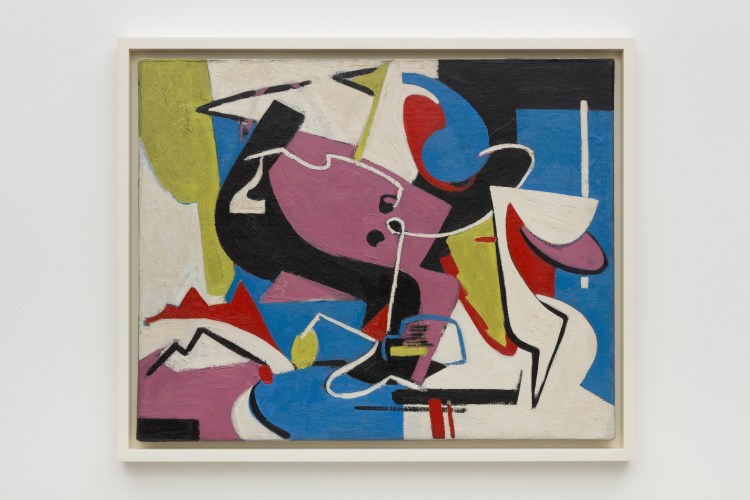
Lee Krasner. “Lavender,” 1942, oil on canvas, 24 x 30 inches. Guillermo Gonzales. Courtesy of the Olivia Collection, Los Angeles and Mexico City. © The Pollock-Krasner Foundation / Artists Rights Society (ARS), New York. Image courtesy of Kasmin Gallery, New York
“Krasner is right there and knows everyone,” Zimmerman said. “That’s the remarkable thing. You realize she was everywhere, knew everyone. She writes about being on the committee that greeted Piet Mondrian to New York and would go out dancing at jazz clubs with this elder statesman.”
The show includes 14 works by Krasner from the 1930s and 1940s, plus pieces from her contemporaries and friends. Zimmerman highlighted one in particular, titled “Lavender” (1942), the kind of painting that he said needs to be viewed in person to appreciate the layers and textures of its surface.
“We think of geometric abstraction as mechanical and can be done by anyone,” Zimmerman said. “It’s really a tour de force of texture and color and moving form that expresses itself in this really remarkable painting.”
“Lee Krasner: Geometries of Expression,” through Nov. 17, Ogunquit Museum of American Art.
JUDITH ROTHSCHILD (1921-1993)
Moss has a book of 200 female artists who worked in abstract expressionism in the 20th century. Some did find acclaim and commercial success, but many did not have the same opportunities to exhibit as their male peers, and major museums today hold fewer of their works.
“There’s a correction in the marketplace and in our institutional approach as well, just saying, OK, literally where are they?” Moss said. “And Judith Rothschild, she was a really important person in what was going on in that movement.”
Rothschild also grew up in New York City and graduated from Wellesley. She studied with Hoffman in New York but also traveled extensively in Europe, and she was at one time the president of the American Abstract Artists.
“She must have been very passionate about bringing what she had been exposed to in Europe to the American discourse on art, and how could those tenets give birth to a uniquely abstract American movement, which is exactly what happened. … She’s at this intersection between the European modernists and the beginning of American abstract expressionism,” Moss said. “Her work has influences of both in the work from the ’50s and ’60s, then she goes on to develop her different changes in style and approach.”
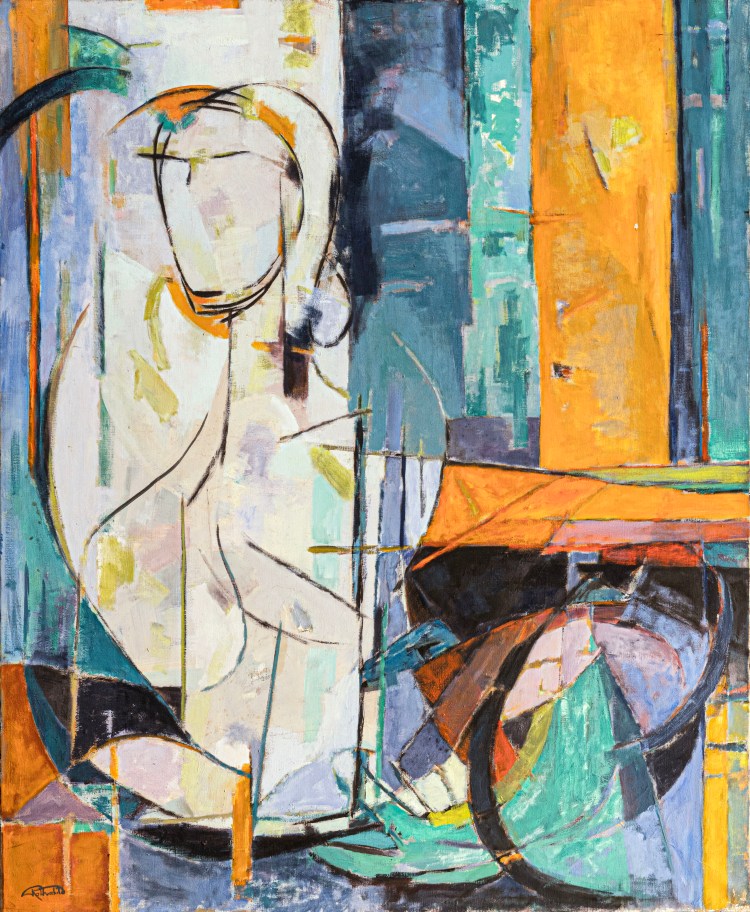
Judith Rothschild. “Portrait of a Young Girl,” 1959. Oil on canvas. 44 x 36 in. Image courtesy of Elizabeth Moss Galleries
Moss said she can see the influence of artists such as Willem De Kooning and even Lynne Drexler over the course of Rothschild’s career.
The exhibition at Moss Galleries spans six decades, which began in formal cubism and loosened over time. “Portrait of a Young Girl” (1958) reflects that evolution; Moss said the figure appears to be breaking apart into floating pieces of color and form. The show includes a more representational work of Dark Harbor in Isleboro, where her brother spent summers and she visited. Later, she worked with relief paintings using white foamboard.
“It used to be frowned upon for an artist to change stylistically over a lifetime,” Moss said. “I think the problem there lies in the audiences not knowing what to expect, but for artists, it’s very common for stylistic changes over a lifetime as interests change and influences come into their lives. It’s a personal journey for their own practice.”
“Judith Rothschild Retrospective: Six Decades of Color and Abstraction,” through Aug. 14, Elizabeth Moss Galleries, Portland.
LYNNE DREXLER (1928-1999)
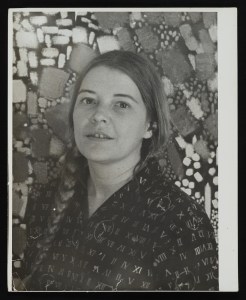
Lynne Drexler in 1960, the decade that an exhibition of her work at the Farnsworth Art Museum focuses on. Photograph of Lynne Drexler, 1960. Lynne Drexler papers, 1956-1980. Archives of American Art, Smithsonian Institution.
Krasner studied with Hoffman in the 1930s; Rothschild, in the 1940s. Drexler was the last of the trio to be his student in the 1950s, near the end of his teaching career. She was among a second generation of abstract expressionist painters that emerged in the middle of the 20th century.
“Though they all studied from Hans Hoffman and learned from him, they had an individual approach,” said Jane Bianco, a curator at the Farnsworth Art Museum. “Their work is quite different and all unique to themselves. What’s so wonderful these days is there is a revival of interest in women in general, but women who were actually active during this abstract expressionist era who may have been off to the side. Their work is really worthy of another look.”
Drexler was born in Virginia and moved to New York in 1956. There, she also studied with Robert Motherwell, who was also an important influence for Rothschild. During her lifetime, she was often overshadowed by her husband, John Hultberg. The couple spent summers on Monhegan until 1983, when they decided to move there full time. Hultberg soon left the island, and the couple separated, but Drexler stayed for the rest of her life.
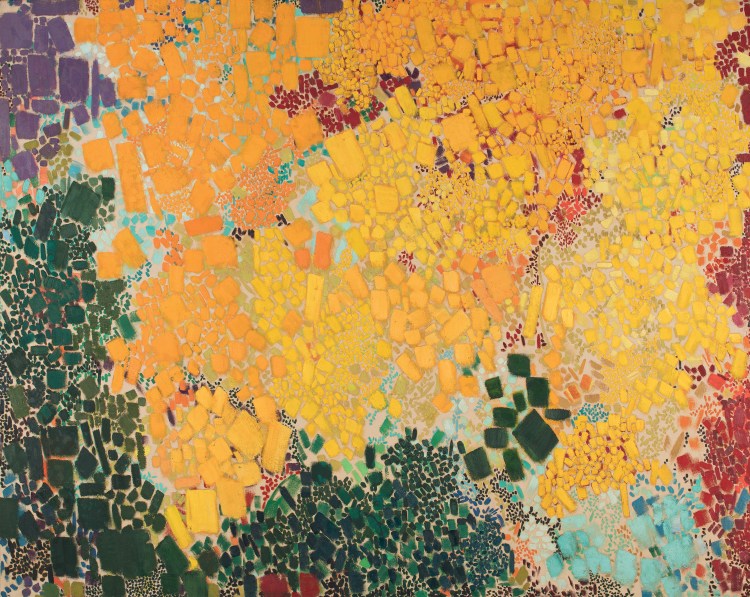
Lynne Drexler (1928-1999). “Cismont,” 1962. Oil on canvas. 68 x 85 1⁄4 inches. Gift from the estate of the artist, 2002.15.1. © 2024 Lynne Drexler by permission of The Lynne Drexler Archive Image courtesy of the Farnsworth Art Museum
The exhibition at the Farnsworth focuses on the 1960s, before Drexler started spending regular time in Maine. Bianco said this period was her most abstract, and the show includes five paintings from the museum’s collection, including four very large works that stretch roughly 5 by 7 feet. The Farnsworth is also showing paintings on loan from the Monhegan Museum of Art and History and two private collectors, as well as a dozen works on paper from the Bates College Museum of Art. (In 2022, the Farnsworth sold two large works by Drexler for a combined $2.7 million with plans to use the proceeds to diversity its collection.)
Bianco said the large scale of these paintings makes her want to step inside them, and she imagined they would feel like the beaded curtains of the 1970s. Her favorite is “Cismont” (1962), which she compared to Gustav Klimt’s “Portrait of Adele Bloch-Bauer” (1907), his famous woman in gold.
“It’s color transposed over color, and they’re not necessarily translucent in her paintings, but it feels as though you could walk into them and meet another field of color,” Bianco said. “They have dimension.”
“Lynne Drexler: Color Notes,” through Jan. 12, Farnsworth Art Museum, Rockland.


